Session Report: “History of the Communication of Science to the Public”
By Brian Schwartz
 Michael Faraday delivering a Christmas Lecture at the Royal Institution in 1856.
Michael Faraday delivering a Christmas Lecture at the Royal Institution in 1856.
 Brian Schwartz reading Karen Rader’s talk.
Brian Schwartz reading Karen Rader’s talk.
The Forum on the History of Physics invited session on “The History of the Communication of Science to the Public” at the Denver American Physical Society meeting in March 2014 featured five speakers who are not only experienced in the subject but currently play a significant role in the communication of science to the public.
Frank Burnet is Emeritus Professor of Science Communication, University of the West of England, and spoke on “The Establishment of Science Communication for the Public at the Royal Institution.” The Royal Institution (RI) was founded in 1799 with one of its missions being “…for teaching …courses of philosophical lectures and experiments, the application of science to the common purposes of life.” There was an emphasis at the Royal Institution on bringing science to the general public, rather than to the specialist. The initiative to create the RI was led by Joseph Banks, the then President of the Royal Society of London, and Benjamin Thompson, an American who fled to England after picking the losing side in the War of Independence and who then became among many other things the Bavarian Army Minister and a Count of the Holy Roman Empire (Count Rumford). Much of the Royal Institution’s early activity was directed towards promoting innovation in the field of agriculture, and the majority of its founding ``proprietors’’ were wealthy landowners. Two of the greatest scientists of their time, Humphry Davy and Michael Faraday, played a key role in the Royal Institution’s outreach to the public programs.
Karen Rader, a historian of science at Virginia Commonwealth University, unfortunately became ill the day before her talk and was unable to be present. She did, however, email her PowerPoint slides and written manuscript, entitled “The Exhibits Revolution in Science and Natural History Museums, 1900-1990;” the chair of the session, Brian Schwartz read and displayed her presentation. By the end of the twentieth century, Rader said, American natural history and science museums had become institutions defined largely by their displays. Her talk made use of life science and physics exhibits to illustrate how and why this transformation occurred. Efforts to modernize displays shaped and were themselves shaped by changing institutional roles and identities for museums in twentieth-century science education and in American culture. Many of her observations were drawn from her co-authored book with Victoria E. M. Cain, Life on Display: Revolutionizing U.S. Museums of Natural History and Science in the Twentieth Century. American efforts to transform museums as institutions of science education and communication pre-date Frank Oppenheimer by at least a half a century, and were modeled on transformations already underway in the late nineteenth century in European museums. A visitor to a place like the Smithsonian would have experienced walking through heavy vertically-oriented museum cases filled with hundreds of taxonomically arranged specimens. By the 1920s, the same visitor would have large dioramas presenting artistically-rendered nature scenes, frozen in time for careful, but distanced, visitor observation. By the mid-1960s, a visit would present “active” displays, like the Boston’s Museum of Science “Transparent Woman.” By the end of the 20th century, scientists were extraordinarily invested in the success of museums’ displays and saw displays as an integral element of their own public outreach work and research agendas.
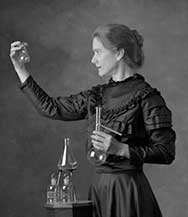
The actor Susan Marie Frontczak in period dress posing as Madame Marie Curie.
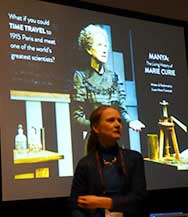
Susan Marie Frontczak speaking about her performances as Marie Curie.
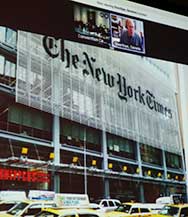
New York Times reporter Dennis Overbye (top center-right) speaking from his office in New York City to the session via Skype. To ask questions, questioners had to come to a laptop on the stage. [Image 450]
Susan Marie Frontczak is a writer, actor and storyteller who spoke on “The Role of Living History in the Communication of Science to the Public.” Frontczak as an actor performes the role of famous and accomplished women before diverse audiences. Her show, “Manya — The Living History of Marie Curie” is a two-hour, full-length adult program. Frontczak aims to reveal the human behind the scientist, while placing Marie Curie’s life and accomplishments in a memorable historical context. This one-woman drama exposes the struggles and triumphs of Madame Marie Curie (née Maria Skłodowska) — an academically impassioned, vehemently private, fervently Polish scientist, mother, and teacher. The drama takes place in 1915 at the outset of the Great War. Her program spans childhood memories, romance, scientific discoveries, and honors; the disruptions incurred by fame, the pain of the loss of her husband, and re-emergence. Susan also developed a one-hour program, “A Visit with Madame Curie,” for adults or for school groups grades 4 through 12, and a 40 minute presentation, “Madame Curie from Childhood through Scientific Discovery,” for younger children. Her performances are followed by a Q&A session, with Frontsczak remaining in the character of Marie Curie throughout.
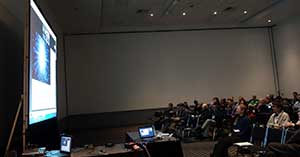
Audience giving rapt attention to Overbye’s Skyped presentation.
Dennis Overbye, a science reporter for The New York Times, spoke on “The Historical Role of the New York Times in the Communication of Science to the Public.” Overbye, unfortunately, was not able to be present in person, but due to the extraordinary effort of the APS IT staff was able to present his talk and PowerPoint slides by 2-way video. More than any United States paper, The New York Times has and continues to play a major role in science reporting. It remains the only US newspaper with a significant science reporting staff and a weekly section, “Science Tuesday” (published since 1978) devoted to science and medicine. The Times produces something like 40,000 words on science a week — half in the Science Times on Tuesday, the other half spread out during the other days of the week. Overbye presented a historical look back to see if and how the Times covered some of the landmark moments in science of the last century. On September 26, 1905, for instance, Einstein published his theory of relativity. Although there were twenty-three stories on the Times front page, relativity was not covered. In fact Einstein’s name would not appear in the Times until 1917, in an article about Einstein’s general theory of relativity, connected to its prediction that light rays would be bent going near the Sun and the bending could be seen in a solar eclipse. Similarly unreported on in the Times was the famous Solvay meeting of the world’s greatest physicists on October 27, 1927, to argue about yet another physics revolution, quantum mechanics, at which Einstein, Bohr, Heisenberg and many other accomplished scientists of the day were present. On April 25, 1953, the date James Watson and Francis Crick published a short paper in Nature disclosing the double helix structure of DNA, the Times buried the lede, only mentioning at the end that this shape provided a basis for the transmission of genes. Ultimately, the science reporting of the Times evolved to a state where reporters consult with a small army of scientist-helpers to make sure they do not miss any more big moments.
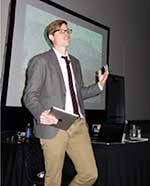
Joseph Hanson
Joseph Hanson, affiliated with PBS Digital Studios, discussed “The Future of the New Media in the Communication of Science.” Hanson demonstrated how new media — based around social networks, ubiquitous consumer technology, and today’s near-universal access to information — has transformed the way that science is communicated to the scientist and non-scientist alike.
He demonstrated that free information and programs on the web can earn significant public following, and thus provide funding for the science communicators as well as the organizations producing and distributing such material. An example of a site which has a significant following and even earns money is “Minute Physics,” by Henry Reich. Discovery is bringing “I F**king Love Science,” a popular Facebook page by creator Elise Andrew with over 10 million likes, to its Science channel in the fourth quarter of 2014. Joe believes we may be in the middle of the greatest shift in information consumption and distribution since the invention of the printing press (or maybe not). He placed today’s new media evolution into perspective, and gave clues as to where social media, digital journalism, open access, and online education will lead science communication in years to come. It remains to be seen whether this new media evolution will translate into a shift in how science is viewed by citizens and policymakers.
The articles in this issue represent the views of their authors and are not necessarily those of the Forum or APS.
